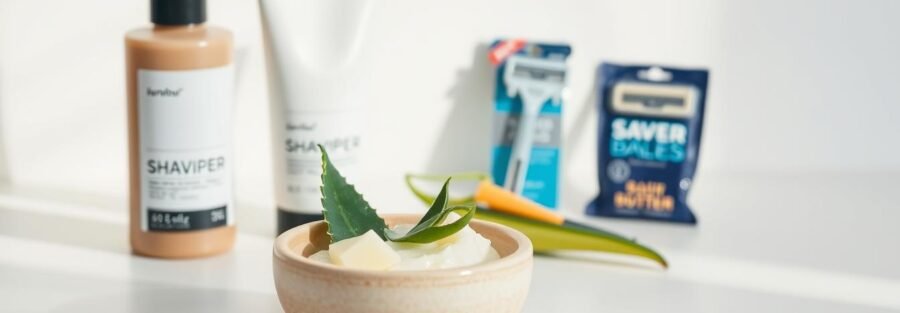Dealing with painful razor bumps and dry, irritated skin after shaving is a common issue many men face. I’ve been there too, and it’s frustrating. The good news is that there’s a straightforward solution that addresses both problems simultaneously without breaking the bank or complicating your routine.
The science behind razor bumps and dry skin is rooted in how hair grows back after shaving. When hair curls back into the skin, it can cause irritation and lead to unsightly bumps. By understanding this process, we can tackle the root cause effectively.
I’ll introduce you to a simple three-step approach that works for all skin types, from sensitive facial skin to coarser body hair regions. By the end of this guide, you’ll have the practical knowledge to transform your shaving routine and achieve the smooth, comfortable skin you’ve been looking for.
Key Takeaways
- Understand the cause of razor bumps and dry skin
- Learn a simple, effective three-step system
- Discover how to achieve smooth, comfortable skin
- Find out how to prevent irritation and burn after shaving
- Get practical tips for improving your shaving routine
Understanding the Razor Problem
Razor-related issues are common, but understanding the root cause can help you find a solution. Shaving can cause a range of problems, from immediate irritation to longer-term ingrown hairs.
Razor Bumps vs. Razor Burn: What’s the Difference?
Razor burn and razor bumps are two distinct issues that occur after shaving. Razor burn is a type of skin irritation caused by the friction of the razor, leading to redness and stinging immediately after shaving. On the other hand, razor bumps, also known as ingrown hairs, develop when hairs grow back into the skin, often appearing days after shaving.
As “The key to treating these conditions lies in understanding their differences.” Razor burn is essentially a form of contact dermatitis caused by friction and chemical irritants in shaving products. In contrast, razor bumps are trapped hairs that become inflamed.
Why Your Skin Gets Irritated After Shaving
Skin irritation after shaving can be attributed to several factors, including dull blades, improper technique, and lack of lubrication. When you shave, you’re not just cutting hair; you’re also removing a layer of skin cells, which can cause irritation. Using a dull razor or shaving against the grain can exacerbate the problem, leading to razor burn and bumps.
To minimize irritation, it’s essential to understand the causes and take steps to prevent them. By adopting the right shaving techniques and using suitable products, you can reduce the risk of razor-related issues.
The Science Behind Razor Bumps and Dry Skin
The science behind razor bumps and dry skin reveals that these issues are closely linked to how our skin reacts to shaving. When we shave, we are not just cutting hair; we are also affecting the skin’s natural barrier.
How Ingrown Hairs Develop
Ingrown hairs develop when hair grows back into the skin rather than up and out. After shaving, waxing, or plucking, the hair may curl and turn inward. New skin cells can grow over the hair, trapping it and causing a bump. This process can lead to painful bumps and inflammation.
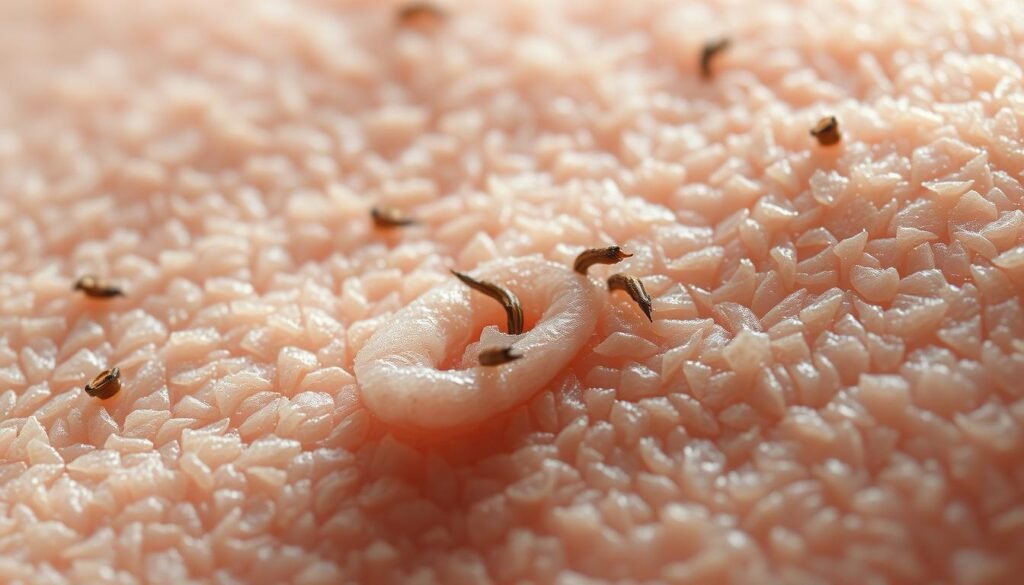
The Connection Between Dry Skin and Razor Irritation
Dry skin and razor irritation are closely connected. When the skin’s natural moisture barrier is disrupted through aggressive shaving, it can lead to both dryness and increased susceptibility to irritation. The role of dead skin cells in trapping hairs beneath the surface creates the perfect conditions for razor bumps to form.
| Cause | Effect |
|---|---|
| Ingrown hairs | Painful bumps and inflammation |
| Dry skin | Increased susceptibility to irritation |
| Aggressive shaving | Disruption of skin’s natural moisture barrier |
Understanding these biological mechanisms is crucial to addressing both razor bumps and dry skin effectively. By knowing how ingrown hairs develop and how dry skin contributes to razor irritation, we can take steps to prevent these issues.
Who’s Most at Risk for Razor Bumps?
While anyone can develop razor bumps, some people are at a higher risk due to their skin and hair characteristics. Individuals with naturally curly or coarse hair are more prone to this issue.
Skin and Hair Types That Struggle Most
People with darker skin tones and those of African descent are more likely to experience razor bumps. This is due to the natural curl pattern of their hair, which can more easily pierce the skin after shaving, leading to inflammation.
Problem Areas: Face, Neck, and Beyond
Razor irritation commonly affects areas like the neck, jawline, and bikini area, where hair growth patterns are more variable. Understanding your personal risk factors is crucial for adapting prevention and treatment strategies to your specific needs.
- Curly, coarse, or thick hair types are more susceptible to razor bumps.
- Darker skin tones may experience more severe razor bumps due to natural hair curl patterns.
- Areas like the neck and jawline are particularly vulnerable to razor irritation.
How to Fix Dry Skin and Razor Bumps with One Simple System
Achieving smooth skin is possible with a simple system that targets dry skin and razor bumps. This comprehensive approach involves three crucial steps that work together to prevent and treat common shaving issues.
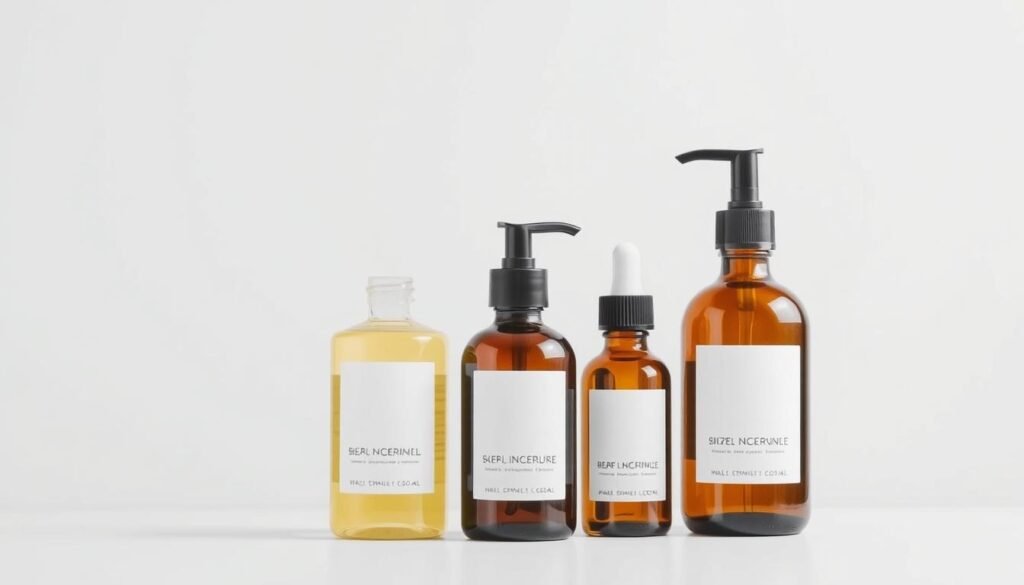
The 3-Step Solution: Prep, Shave, Treat
The foundation of this system lies in its three core components: preparation, shaving, and aftercare. Pre-shave preparation involves exfoliating and hydrating the skin, for which products like Visual Chemistry – Exfoliating Face Scrub are highly effective. Proper shaving technique is the next step, where using a high-quality razor such as the Braun Series 9 Pro Shave can make a significant difference. Finally, post-shave treatment helps to soothe and moisturize the skin, reducing irritation and dryness.
This three-step solution creates a cycle of skin improvement. By preparing the skin properly before shaving, you reduce the risk of razor bumps and irritation. Using the right shaving technique further minimizes these risks, and appropriate aftercare helps to heal any existing issues, leading to healthier skin over time.
Why This System Works for Everyone
The beauty of this system lies in its universality. Regardless of your skin type or hair texture, this three-step approach addresses the fundamental causes of dry skin and razor bumps rather than just treating the symptoms. By customizing the products used in each step according to your specific needs, you can effectively tackle shaving-related issues across different body areas, from the face and neck to other sensitive regions.
Step 1: Proper Pre-Shave Preparation
Before you even pick up your razor, preparing your skin is crucial. Proper pre-shave preparation can make all the difference between a smooth shave and irritated skin.
Exfoliation Techniques That Prevent Ingrown Hairs
Exfoliating before shaving is essential to prevent ingrown hairs. By removing dead skin cells, you allow your razor to glide more smoothly, reducing the risk of razor burn and bumps. For men, using an exfoliating face scrub like Visual Chemistry can be highly effective.
There are two main types of exfoliation: physical and chemical. Physical exfoliation involves scrubbing your skin with a product containing abrasive particles, while chemical exfoliation uses ingredients like salicylic acid and glycolic acid to dissolve dead skin cells.
Hydrating Your Skin Before Shaving
Hydrating your skin is just as important as exfoliating. Soaking your skin for at least 2-3 minutes before shaving can significantly reduce friction and irritation. You can do this by shaving during or right after a shower, or by applying a warm, wet towel to the area for 5 minutes.
Cleansing your skin with a non-comedogenic product helps clear pores and remove excess skin cells, ensuring a smoother shave and reducing the risk of ingrown hairs.
Step 2: Perfect Shaving Technique
Achieving a smooth shave without irritation is all about mastering the perfect shaving technique. A good shave requires more than just a razor; it demands a thoughtful approach to your skin and hair.
Choosing the Right Razor and Products
Selecting the right razor is crucial. For instance, the Braun Series 9 Pro Shave is an excellent option that helps prevent irritation and provides a close, comfortable shave.
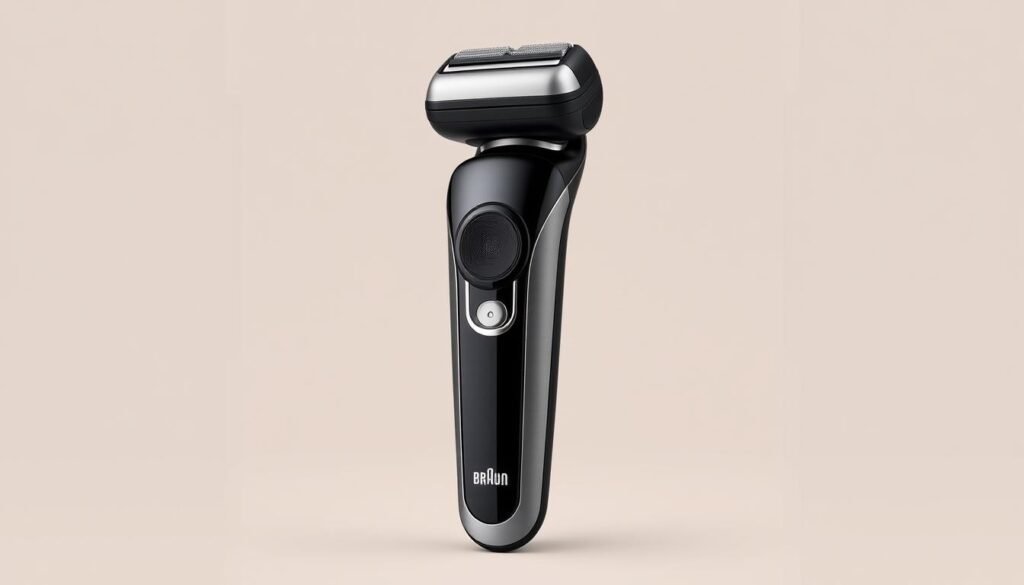
The type of razor you use can significantly impact your shaving experience. There are various razors available, including cartridge, safety, and electric razors. Each has its benefits and is suited for different skin and hair types.
- Cartridge razors are convenient and easy to use, making them suitable for most users.
- Safety razors are ideal for those with sensitive skin as they cause less irritation.
- Electric razors are perfect for a quick shave and can be adjusted for different hair lengths.
Using quality shaving cream or gel is also non-negotiable. These products create a necessary barrier between your skin and the blade, preventing friction and dryness.
The Correct Direction and Pressure
Shaving with the grain of your hair growth, rather than against it, is critical, especially for those prone to ingrown hairs. Applying the right amount of pressure and holding your razor at the correct angle are also vital for a smooth shave.
To avoid razor bumps and burn, shave slowly and carefully, following the direction of hair growth. Avoid pulling the skin tight while shaving and refrain from repeating strokes in one area.
Step 3: Essential Post-Shave Care
After shaving, your skin needs special attention to prevent irritation. The first few minutes after shaving are critical, as your skin is most vulnerable to irritation and dryness.
Immediate After-Shave Treatment
To soothe and calm your skin, start by rinsing off all shaving cream with warm water. Then, apply a cool compress to the skin for 5 minutes to help reduce inflammation. Next, apply an aftershave that’s formulated to prevent razor bumps and soothe the skin. Look for alcohol-free aftershaves containing anti-inflammatory ingredients like aloe vera and witch hazel.
I recommend using Happy Nuts grooming products for post-shave hygiene and body care, especially for sensitive areas prone to irritation.
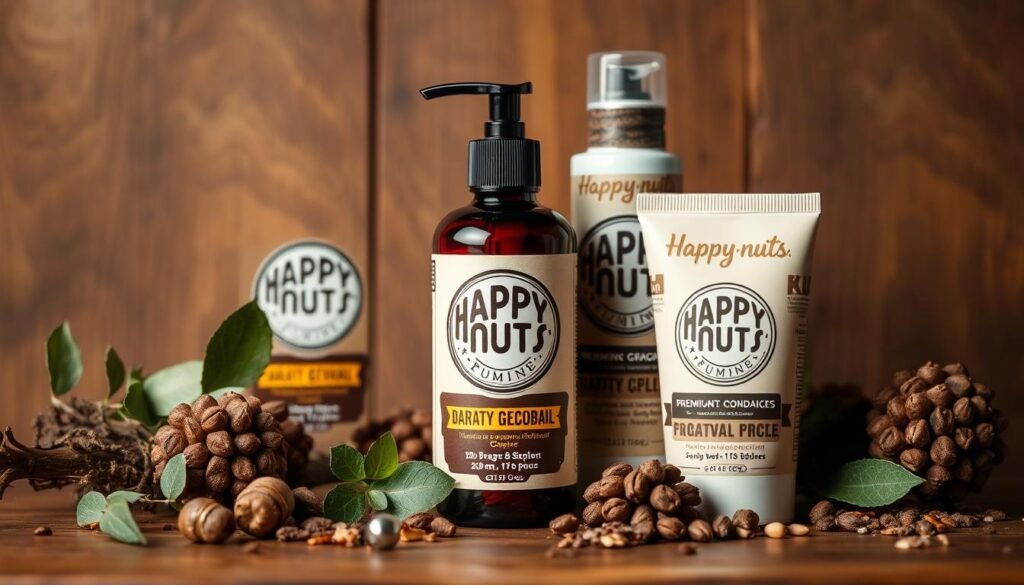
Daily Moisturizing Routine for Problem Areas
Consistent daily moisturizing is crucial, even on non-shaving days, to maintain skin barrier health and prevent dryness that contributes to irritation. For problem areas, consider using a rich moisturizer like Buttah Skin Supreme Skin Kit.
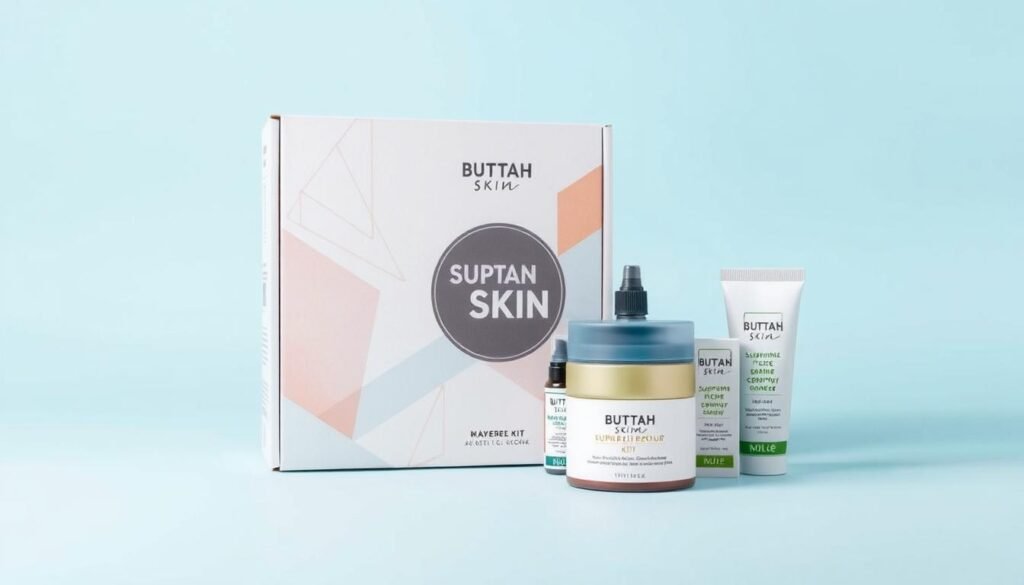
By following this simple post-shave care routine, you can significantly reduce the occurrence of razor bumps and irritation, keeping your skin healthy and smooth.
Treating Existing Razor Bumps and Irritation
Razor bumps and irritation can be a nuisance, but with the right treatment, you can achieve smoother skin. When you’ve already developed razor bumps, there are several effective strategies to alleviate the discomfort and promote healing.
Fast-Acting Home Remedies
For immediate relief, consider using a cold compress to reduce inflammation and soothe the skin. Simply wrap ice cubes in a clean cloth or use a cold gel pack and gently press it against the affected area for a few minutes. Repeat this process throughout the day as needed. Another effective remedy is aloe vera, known for its soothing, anti-inflammatory, and healing properties. Apply pure aloe vera gel directly to the irritated area to help moisturize the skin, reduce redness, and promote faster healing.
| Remedy | Benefits | Application |
|---|---|---|
| Cold Compress | Reduces inflammation, soothes skin | Wrap ice in cloth, apply for a few minutes |
| Aloe Vera | Moisturizes, reduces redness, promotes healing | Apply pure gel directly to irritated area |
When to Consider Medical Treatment
If your razor bumps become severely inflamed, infected, or persist despite trying home remedies, it may be time to consult a dermatologist. They can provide guidance on further treatment, such as topical creams or other interventions, to help resolve the issue and prevent future occurrences.
Conclusion: Smooth Skin Is Within Reach
Achieving smooth, comfortable skin is within reach with a simple three-step system. By following our Prep, Shave, Treat approach, you can address both the causes and symptoms of razor bumps and dry skin.
To recap, we’ve covered the importance of proper pre-shave preparation, including exfoliation and hydration. We’ve also discussed perfect shaving techniques and essential post-shave care to help reduce irritation.
With consistent practice, you can expect to see improvements in a few weeks. Remember to personalize this system to your skin type, hair texture, and problem areas. For a smoother shave, consider trying products like Happy Nuts, Visual Chemistry – Exfoliating Face Scrub, and Braun Series9 Pro Shave.
Affiliate Disclosure:
Some of the links in this post are affiliate links, which means I may earn a small commission if you make a purchase at no extra cost to you. I only recommend products I personally use or believe add real value. Thanks for supporting Manly Picks and helping keep the content honest and real.

